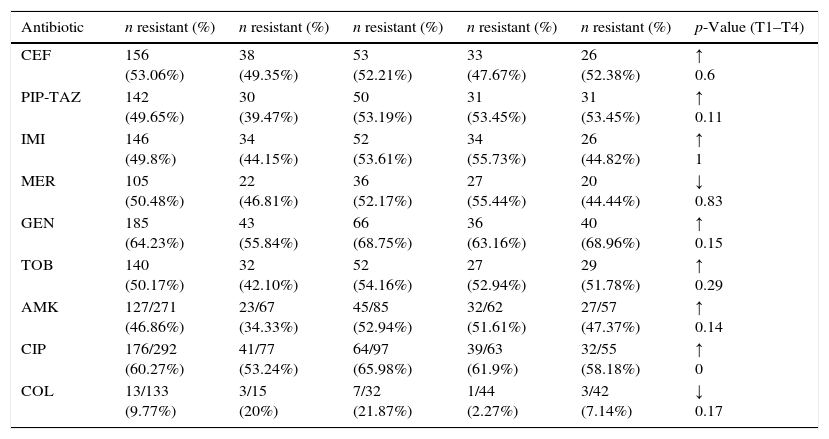Pseudomonas aeruginosa is a clinical and epidemiological significant pathogen involved especially in infections in hospitalized patients, with an increasing antimicrobial resistance over the past few years. Till recently, Romania's involvement in antimicrobial surveillance networks was weak.1 Therefore, we conducted a study in order to determine the antimicrobial resistance of P. aeruginosa isolated from various clinical specimens.
We analyzed the antimicrobial susceptibility profiles of 296 P. aeruginosa strains isolated from patients hospitalized in “Prof. Dr. Matei Bals” National Institute of Infectious Diseases in Bucharest, Romania, between July 1st 2008 and June 30th 2010. We analyzed the dynamics of the resistance between four semesters.
The overall resistance rates were: colistin 9.77%, amikacin 46.86%, imipenem 49.8%, piperacillin/tazobactam 49.65%, meropenem 50.48%, tobramycin 50.17%, ceftazidime 53.06%, ciprofloxacin 60.27%, and gentamicin 64.23%.
The analysis of the temporal evolution of P. aeruginosa resistance to antimicrobials is illustrated in Table 1. The resistance rates increased between the initial and the final semester for all the antibiotics, but colistin and meropenem. Except for ceftazidime and piperacillin-tazobactam for which the trend was continuously increasing, for all the other antibiotics the evolution of the resistance was undulating. None of these trends were statistically significant between the initial and the final semester of the study.
Antimicrobial resistance of Pseudomonas aeruginosa strains.
| Antibiotic | n resistant (%) | n resistant (%) | n resistant (%) | n resistant (%) | n resistant (%) | p-Value (T1–T4) |
|---|---|---|---|---|---|---|
| CEF | 156 (53.06%) | 38 (49.35%) | 53 (52.21%) | 33 (47.67%) | 26 (52.38%) | ↑ 0.6 |
| PIP-TAZ | 142 (49.65%) | 30 (39.47%) | 50 (53.19%) | 31 (53.45%) | 31 (53.45%) | ↑ 0.11 |
| IMI | 146 (49.8%) | 34 (44.15%) | 52 (53.61%) | 34 (55.73%) | 26 (44.82%) | ↑ 1 |
| MER | 105 (50.48%) | 22 (46.81%) | 36 (52.17%) | 27 (55.44%) | 20 (44.44%) | ↓ 0.83 |
| GEN | 185 (64.23%) | 43 (55.84%) | 66 (68.75%) | 36 (63.16%) | 40 (68.96%) | ↑ 0.15 |
| TOB | 140 (50.17%) | 32 (42.10%) | 52 (54.16%) | 27 (52.94%) | 29 (51.78%) | ↑ 0.29 |
| AMK | 127/271 (46.86%) | 23/67 (34.33%) | 45/85 (52.94%) | 32/62 (51.61%) | 27/57 (47.37%) | ↑ 0.14 |
| CIP | 176/292 (60.27%) | 41/77 (53.24%) | 64/97 (65.98%) | 39/63 (61.9%) | 32/55 (58.18%) | ↑ 0 |
| COL | 13/133 (9.77%) | 3/15 (20%) | 7/32 (21.87%) | 1/44 (2.27%) | 3/42 (7.14%) | ↓ 0.17 |
T1 (July 1st 2008–December 31st 2008), T2 (January 1st 2009–June 30th 2009), T3 (July 1st 2009–December 31st 2009), T4 (January 1st 2010–June 30th 2010), CEF, ceftazidime; PIP/TAZ, piperacillin-tazobactam; IMI, imipenem; MER, meropenem; GEN, gentamicin; TOB, tobramycin; AMK, amikacin; CIP, ciprofloxacin; COL, colistin.
Among the three representatives of the aminoglycosides class, amikacin proved to be superior to gentamicin. We did not find any statistically significant differences between tobramycin and amikacin, or between tobramycin and gentamicin.
The comparative analysis for each time frame regarding the efficiency of antipseudomonal betalactams did not reveal any statistical significance between resistance rates of ceftazidime versus piperacillin/tazobactam, ceftazidim versus imipenem/meropenem, piperacillin-tazobactam versus imipenem/meropenem.
With a good activity, colistin remains the salvage therapy for P. aeruginosa infections.
A total of 161 strains of P. aeruginosa (54.39%) were resistant to at least three of the antimicrobial groups among piperacillin-tazobactam, ceftazidime, aminoglycosides, fluoroquinolones, carbapenems, and colistin.
Following this study, the first attempt to introduce an antimicrobial stewardship programme was made in our hospital in 2010. In addition, regional therapeutic recommendations previously made on rational criteria were modified in relation to the resistance problems described and the need for limiting the negative evolutionary trends on bacterial susceptibility to antibiotics.2
This study emphasizes that P. aeruginosa isolates are becoming increasingly resistant to antibiotics in our country, leaving clinicians with very limited treatment options for these infections. With such high resistance rates to all the antipseudomonal antibiotic classes, including carbapenems, only colistin seems to be a safe treatment option for infections in which this etiology is suspected.
In our country it is imperative to continuously monitor the antimicrobial resistance patterns as well as to introduce antimicrobial stewardship programs in order to limit the rising resistance rates and the spread of these resistant isolates.
FundingThis work was supported by EUFISCDI (PNCDI II 41-048/14.09.2007-programme 4).
Conflicts of interestThe authors declare no conflicts of interest.





